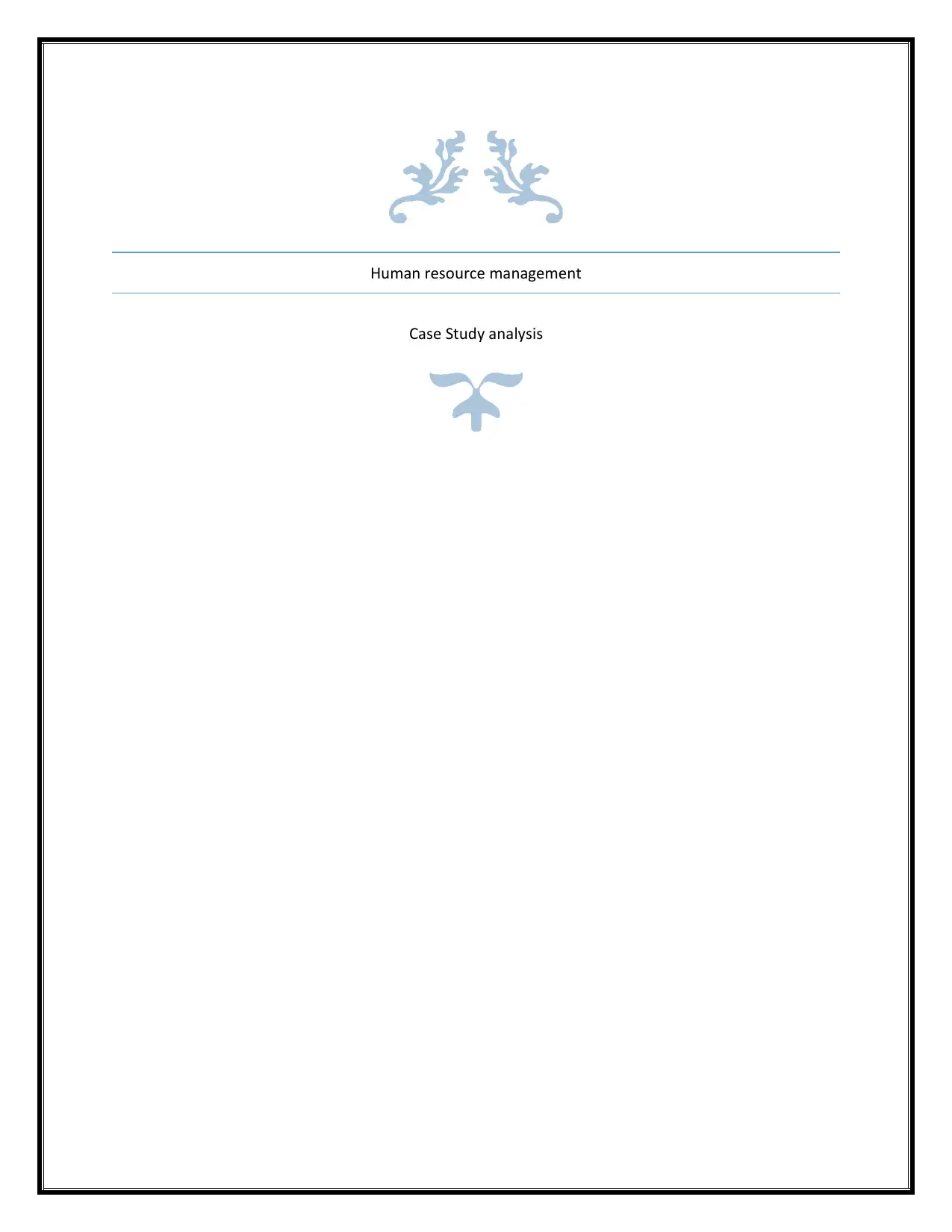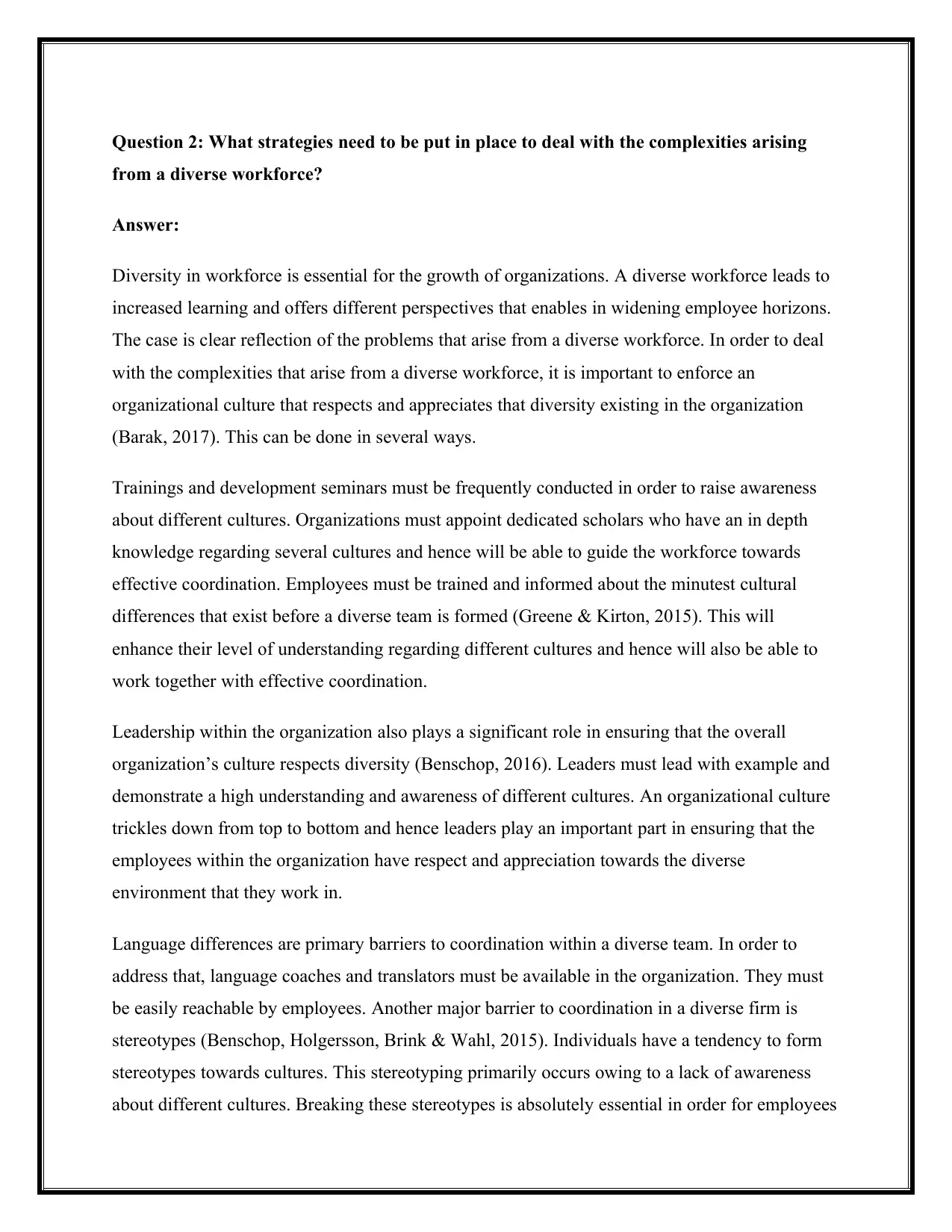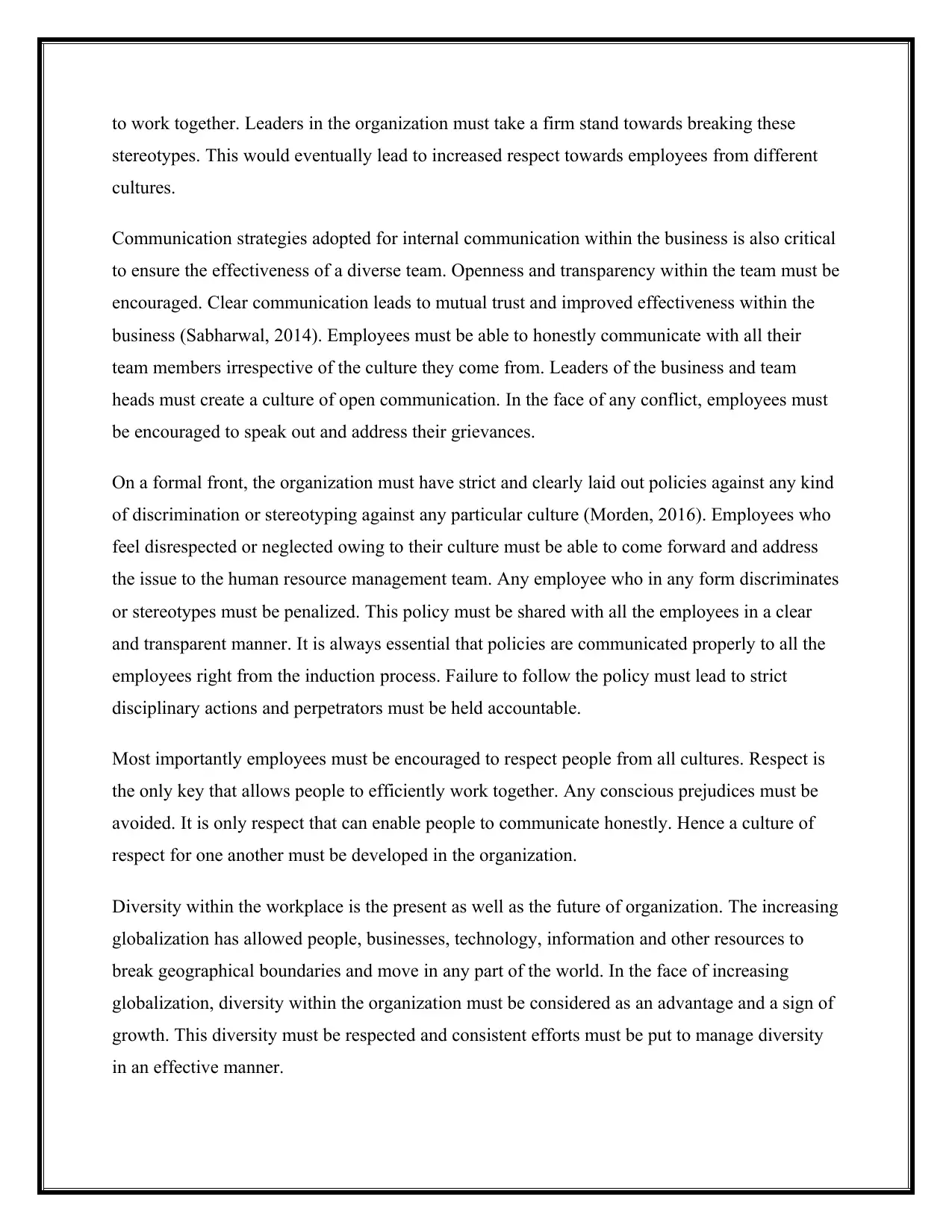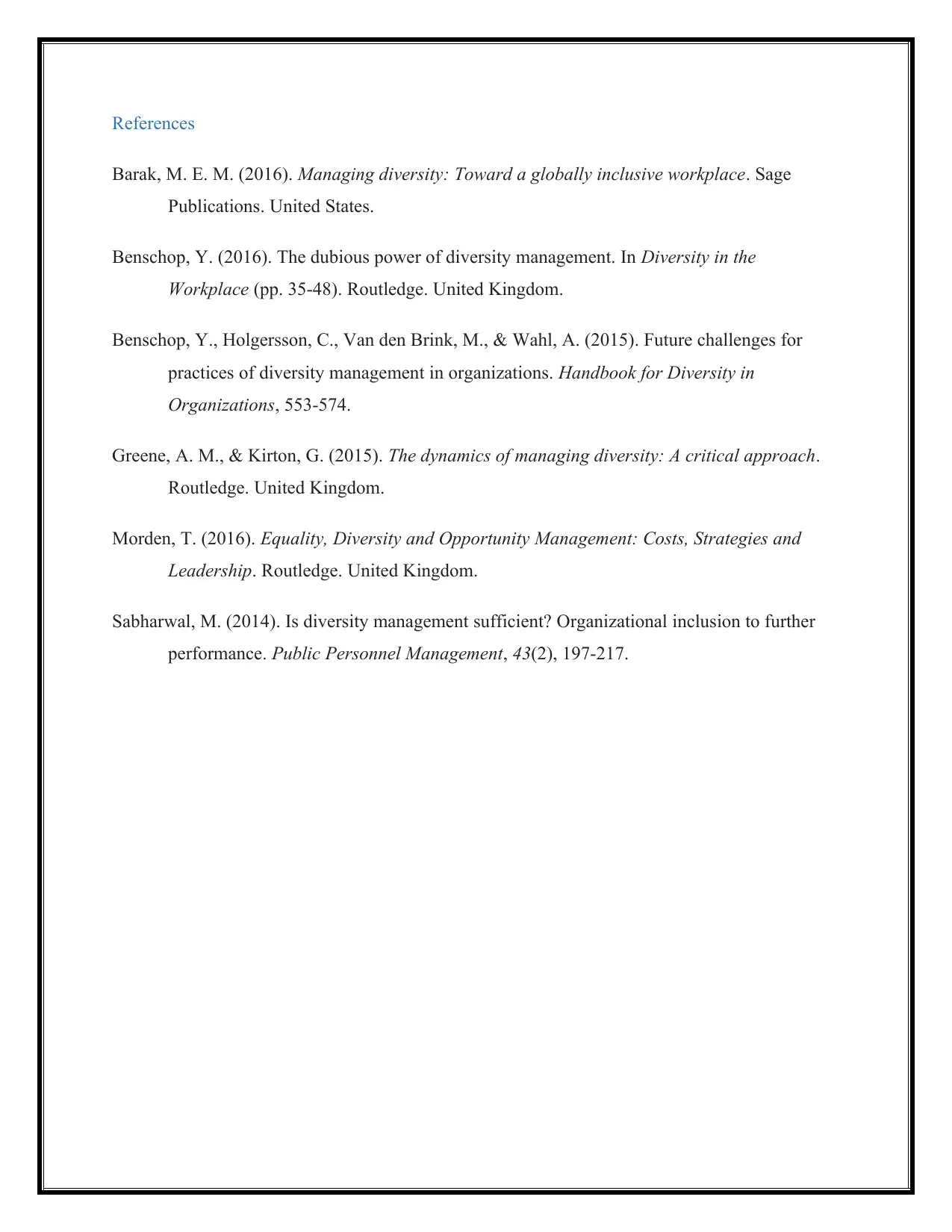HRM Case Study: Strategic Approaches to Workforce Diversity Issues
VerifiedAdded on 2023/06/04
|4
|970
|223
Case Study
AI Summary
This assignment presents a case study analysis focusing on Human Resource Management (HRM) strategies required to effectively manage the complexities arising from a diverse workforce. It emphasizes the importance of fostering an organizational culture that respects and appreciates diversity through regular training, cultural awareness programs, and the appointment of cultural experts. The role of leadership in promoting inclusivity and addressing language barriers and stereotypes is highlighted, along with the need for clear communication strategies and strict policies against discrimination. The analysis underscores that embracing diversity is essential for organizational growth in an increasingly globalized world, advocating for proactive and consistent efforts to manage diversity effectively by promoting mutual respect and understanding among employees.

Human resource management
Case Study analysis
Case Study analysis
Paraphrase This Document
Need a fresh take? Get an instant paraphrase of this document with our AI Paraphraser

Question 2: What strategies need to be put in place to deal with the complexities arising
from a diverse workforce?
Answer:
Diversity in workforce is essential for the growth of organizations. A diverse workforce leads to
increased learning and offers different perspectives that enables in widening employee horizons.
The case is clear reflection of the problems that arise from a diverse workforce. In order to deal
with the complexities that arise from a diverse workforce, it is important to enforce an
organizational culture that respects and appreciates that diversity existing in the organization
(Barak, 2017). This can be done in several ways.
Trainings and development seminars must be frequently conducted in order to raise awareness
about different cultures. Organizations must appoint dedicated scholars who have an in depth
knowledge regarding several cultures and hence will be able to guide the workforce towards
effective coordination. Employees must be trained and informed about the minutest cultural
differences that exist before a diverse team is formed (Greene & Kirton, 2015). This will
enhance their level of understanding regarding different cultures and hence will also be able to
work together with effective coordination.
Leadership within the organization also plays a significant role in ensuring that the overall
organization’s culture respects diversity (Benschop, 2016). Leaders must lead with example and
demonstrate a high understanding and awareness of different cultures. An organizational culture
trickles down from top to bottom and hence leaders play an important part in ensuring that the
employees within the organization have respect and appreciation towards the diverse
environment that they work in.
Language differences are primary barriers to coordination within a diverse team. In order to
address that, language coaches and translators must be available in the organization. They must
be easily reachable by employees. Another major barrier to coordination in a diverse firm is
stereotypes (Benschop, Holgersson, Brink & Wahl, 2015). Individuals have a tendency to form
stereotypes towards cultures. This stereotyping primarily occurs owing to a lack of awareness
about different cultures. Breaking these stereotypes is absolutely essential in order for employees
from a diverse workforce?
Answer:
Diversity in workforce is essential for the growth of organizations. A diverse workforce leads to
increased learning and offers different perspectives that enables in widening employee horizons.
The case is clear reflection of the problems that arise from a diverse workforce. In order to deal
with the complexities that arise from a diverse workforce, it is important to enforce an
organizational culture that respects and appreciates that diversity existing in the organization
(Barak, 2017). This can be done in several ways.
Trainings and development seminars must be frequently conducted in order to raise awareness
about different cultures. Organizations must appoint dedicated scholars who have an in depth
knowledge regarding several cultures and hence will be able to guide the workforce towards
effective coordination. Employees must be trained and informed about the minutest cultural
differences that exist before a diverse team is formed (Greene & Kirton, 2015). This will
enhance their level of understanding regarding different cultures and hence will also be able to
work together with effective coordination.
Leadership within the organization also plays a significant role in ensuring that the overall
organization’s culture respects diversity (Benschop, 2016). Leaders must lead with example and
demonstrate a high understanding and awareness of different cultures. An organizational culture
trickles down from top to bottom and hence leaders play an important part in ensuring that the
employees within the organization have respect and appreciation towards the diverse
environment that they work in.
Language differences are primary barriers to coordination within a diverse team. In order to
address that, language coaches and translators must be available in the organization. They must
be easily reachable by employees. Another major barrier to coordination in a diverse firm is
stereotypes (Benschop, Holgersson, Brink & Wahl, 2015). Individuals have a tendency to form
stereotypes towards cultures. This stereotyping primarily occurs owing to a lack of awareness
about different cultures. Breaking these stereotypes is absolutely essential in order for employees

to work together. Leaders in the organization must take a firm stand towards breaking these
stereotypes. This would eventually lead to increased respect towards employees from different
cultures.
Communication strategies adopted for internal communication within the business is also critical
to ensure the effectiveness of a diverse team. Openness and transparency within the team must be
encouraged. Clear communication leads to mutual trust and improved effectiveness within the
business (Sabharwal, 2014). Employees must be able to honestly communicate with all their
team members irrespective of the culture they come from. Leaders of the business and team
heads must create a culture of open communication. In the face of any conflict, employees must
be encouraged to speak out and address their grievances.
On a formal front, the organization must have strict and clearly laid out policies against any kind
of discrimination or stereotyping against any particular culture (Morden, 2016). Employees who
feel disrespected or neglected owing to their culture must be able to come forward and address
the issue to the human resource management team. Any employee who in any form discriminates
or stereotypes must be penalized. This policy must be shared with all the employees in a clear
and transparent manner. It is always essential that policies are communicated properly to all the
employees right from the induction process. Failure to follow the policy must lead to strict
disciplinary actions and perpetrators must be held accountable.
Most importantly employees must be encouraged to respect people from all cultures. Respect is
the only key that allows people to efficiently work together. Any conscious prejudices must be
avoided. It is only respect that can enable people to communicate honestly. Hence a culture of
respect for one another must be developed in the organization.
Diversity within the workplace is the present as well as the future of organization. The increasing
globalization has allowed people, businesses, technology, information and other resources to
break geographical boundaries and move in any part of the world. In the face of increasing
globalization, diversity within the organization must be considered as an advantage and a sign of
growth. This diversity must be respected and consistent efforts must be put to manage diversity
in an effective manner.
stereotypes. This would eventually lead to increased respect towards employees from different
cultures.
Communication strategies adopted for internal communication within the business is also critical
to ensure the effectiveness of a diverse team. Openness and transparency within the team must be
encouraged. Clear communication leads to mutual trust and improved effectiveness within the
business (Sabharwal, 2014). Employees must be able to honestly communicate with all their
team members irrespective of the culture they come from. Leaders of the business and team
heads must create a culture of open communication. In the face of any conflict, employees must
be encouraged to speak out and address their grievances.
On a formal front, the organization must have strict and clearly laid out policies against any kind
of discrimination or stereotyping against any particular culture (Morden, 2016). Employees who
feel disrespected or neglected owing to their culture must be able to come forward and address
the issue to the human resource management team. Any employee who in any form discriminates
or stereotypes must be penalized. This policy must be shared with all the employees in a clear
and transparent manner. It is always essential that policies are communicated properly to all the
employees right from the induction process. Failure to follow the policy must lead to strict
disciplinary actions and perpetrators must be held accountable.
Most importantly employees must be encouraged to respect people from all cultures. Respect is
the only key that allows people to efficiently work together. Any conscious prejudices must be
avoided. It is only respect that can enable people to communicate honestly. Hence a culture of
respect for one another must be developed in the organization.
Diversity within the workplace is the present as well as the future of organization. The increasing
globalization has allowed people, businesses, technology, information and other resources to
break geographical boundaries and move in any part of the world. In the face of increasing
globalization, diversity within the organization must be considered as an advantage and a sign of
growth. This diversity must be respected and consistent efforts must be put to manage diversity
in an effective manner.
⊘ This is a preview!⊘
Do you want full access?
Subscribe today to unlock all pages.

Trusted by 1+ million students worldwide

References
Barak, M. E. M. (2016). Managing diversity: Toward a globally inclusive workplace. Sage
Publications. United States.
Benschop, Y. (2016). The dubious power of diversity management. In Diversity in the
Workplace (pp. 35-48). Routledge. United Kingdom.
Benschop, Y., Holgersson, C., Van den Brink, M., & Wahl, A. (2015). Future challenges for
practices of diversity management in organizations. Handbook for Diversity in
Organizations, 553-574.
Greene, A. M., & Kirton, G. (2015). The dynamics of managing diversity: A critical approach.
Routledge. United Kingdom.
Morden, T. (2016). Equality, Diversity and Opportunity Management: Costs, Strategies and
Leadership. Routledge. United Kingdom.
Sabharwal, M. (2014). Is diversity management sufficient? Organizational inclusion to further
performance. Public Personnel Management, 43(2), 197-217.
Barak, M. E. M. (2016). Managing diversity: Toward a globally inclusive workplace. Sage
Publications. United States.
Benschop, Y. (2016). The dubious power of diversity management. In Diversity in the
Workplace (pp. 35-48). Routledge. United Kingdom.
Benschop, Y., Holgersson, C., Van den Brink, M., & Wahl, A. (2015). Future challenges for
practices of diversity management in organizations. Handbook for Diversity in
Organizations, 553-574.
Greene, A. M., & Kirton, G. (2015). The dynamics of managing diversity: A critical approach.
Routledge. United Kingdom.
Morden, T. (2016). Equality, Diversity and Opportunity Management: Costs, Strategies and
Leadership. Routledge. United Kingdom.
Sabharwal, M. (2014). Is diversity management sufficient? Organizational inclusion to further
performance. Public Personnel Management, 43(2), 197-217.
1 out of 4
Related Documents
Your All-in-One AI-Powered Toolkit for Academic Success.
+13062052269
info@desklib.com
Available 24*7 on WhatsApp / Email
![[object Object]](/_next/static/media/star-bottom.7253800d.svg)
Unlock your academic potential
Copyright © 2020–2025 A2Z Services. All Rights Reserved. Developed and managed by ZUCOL.





